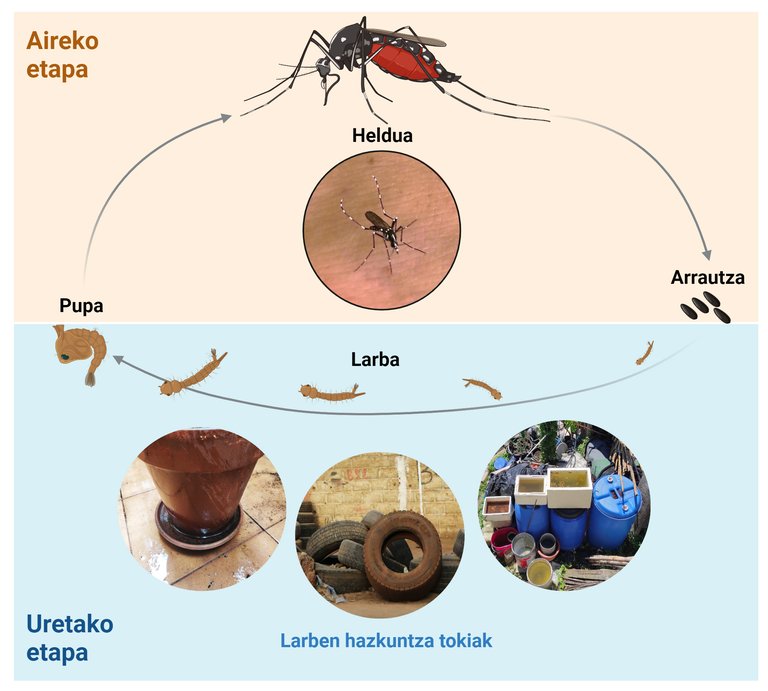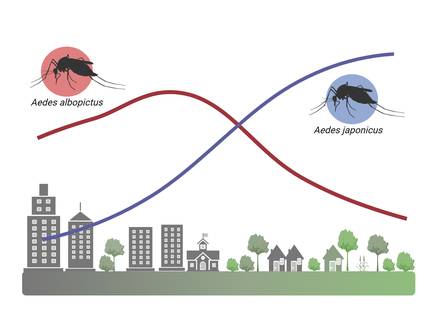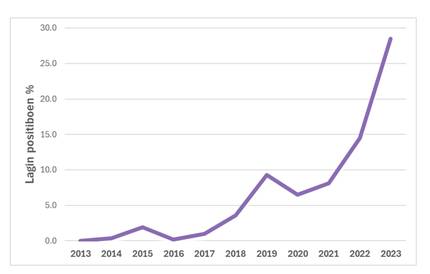From night hum to day punctures?
Who hasn't spent a summer night listening to that annoying hum that we hate so much all of a sudden when we're about to sleep in bed? The common mosquito of the species Culex pipipiens is usually responsible for this noise. However, in recent years we have had to face a new situation: the silent punctures of the day. Eltxo is a tiger that has decided to change the game rules we know about mosquitoes.

Mosquitoes play a fundamental role in public and animal health, due to their ability as vectors of various pathogens and their impact on quality of life as piercing insects. Globalization, human travel and global trade have facilitated the spread of exotic invasive mosquitoes of the Aedes genus. Climate and environmental changes also increase their potential for expansion and deployment in new regions. In Europe, six species of invasive mosquitoes of the genus Aedes have been introduced since the 1970s, some of which have generated stable populations. Two of them have been found in our territory.
Who is the tiger eltxo?
The Eltxo tiger, scientifically Aedes albopictus, native to Southeast Asia, has managed to spread throughout the world thanks to its ability to advance in many environments. It has mainly spread to temperate and tropical regions of some continents, such as Europe, North and South America, Africa, the Pacific and India. It was first discovered in Europe in Albania in the late 1970s and later in Italy in the 1990s. It has since been progressively extended to other Mediterranean countries [1]. Aedes albopictus’ success in adapting to new territories is attributed to its ability to combat low temperatures and winter in temperate areas, as well as its ability to adapt to certain habitats affected by globalisation and climate change [2].
It has characteristic black and white marks in body and legs (hence the name tiger). This species is characterized by its daytime activity, especially by other mosquitoes known in our country, but also by its ability to reproduce in small containers of stagnant water (Figure 1). The latter is one of the secrets of its expansion, as one of the reasons for its expansion is, to a large extent, its excellent ability to grow in artificial containers found in private gardens and urban environments. Unlike many other species of mosquitoes that grow primarily in natural pools or wetlands, Ae. the albopictus is perfectly suited to small man-made containers that may contain water: pots, discarded tires, animal watchers, etc., i.e. any small element that can store rainwater [2].
This behavior allows mosquitoes to advance in urban areas with a large human population. Even more so when areas of potential growth are numerous, as they are often not cared for. The growing sites of the private gardens, along with abandoned garbage and other water-tight objects, create unbeatable conditions in Ae. establish and reproduce albopictus populations. As a result, efforts to properly eliminate or manage these container habitats are essential to control the spread of the tiger mosquito and reduce the risk of disease in urban areas.
Yes, indeed, the mosquito tiger is a threat to public health, because it is capable of transmitting viral diseases to humans. Among them, dengue, chikunguny and citric acid, all with the potential to produce epidemic outbreaks. In addition to the health risk, the presence of the tiger mosquito can adversely affect the quality of life and tourism.
In our territory
The rapid expansion of the Eltxo tiger is causing great concern for public health throughout Europe, especially in the Mediterranean basin, but in recent years also in our own. After its detection in the southwest of Aquitaine in 2012, an entomological surveillance program was launched in 2013 in Hego Euskal Herria. Thanks to this initiative, in 2014 Ae. Albopictus eggs were first identified in Behobia [3]. During the first three years NEIKER performed entomological surveillance. As of 2016, Public Health personnel from the Basque Government and municipal staff from the three territories joined in carrying out the sampling work, which meant an important expansion of surveillance. With the data analyzed in a first study, between 2013 and 2018 [3], the expansion and consolidation of the tiger mosquito was confirmed. In addition, a significant increase in the number of bites was detected in the Sanitary Region of Bidasoa by 2018 [3].
But this is not the only exotic mosquito we have in us. In fact, in 2020, the Asian mosquito Aedes japonicus was first detected in several localities of the Basque Country [4]. This species of mosquito is adapted to temperate climates, but it has the ability to withstand cold, snowy winters. Unlike Aedes albopictus, Ae. The Commission's proposal is based on the principle of subsidiarity. Although it is not a primary risk for humans, Ae. Japicus is believed to have the potential to vector some viruses, including chikungunya, dengue, Zika and West Nile viruses.

Aedes albopictus and Ae expansion in 2020 in the three Basque provinces. As a consequence of japanese perception, a study was conducted in 2021 to evaluate the distribution of these mosquito species and their relationship with urbanization factors [5]. Entomological surveillance data for 2021 were analyzed (568 obitrans in 113 sites, in 45 municipalities). The study showed that the spread of Aedes invading mosquitoes became a reality by finding eggs in 66% of places. Yes Ae. albopictus and Ae. Japonicus was widespread in 23 and 26 municipalities respectively. The presence of both species was detected in 11 municipalities. The analysis of the presence and urbanization of mosquitoes showed Ae. that the albopictus was mainly located in urban and periurban areas, and Ae. Japonicus in periurban and peri-urban areas (Figure 2). Also Ae. albopictus was associated with municipalities with higher population density; Ae. Japanese with lower population densities. This highlighted the importance of surveillance and control programs adapted to the different levels of urbanization, environmental contexts and population densities to address the possible impact of these invasive mosquitoes on public health.
Although in our country we have known the mosquito tiger since 2014, in general, until 2023 the consequences among the population have not begun to be noticed, except in some municipalities that have suffered these mosquitoes for a long time, especially in the region of Bidasoa. As already mentioned, these diptera have a significant impact on the quality of life of the population due to the intense activities and stings of the day, confirmed by the news boom published in 2023. Entomological surveillance data from recent years have shown that, year after year, these species are increasing in our territory, and last summer weather conditions seem beneficial for them, especially for the tiger mosquito (Figure 3).

How do we deal with it?
The prevention and control of the tiger Eltxo requires a comprehensive vision that involves the community, local authorities and public health experts. Permanent care and collaboration among different sectors is fundamental to face this complex multifactorial problem. Furthermore, given that between 60% and 80% of the mosquito growing areas are privately owned [6], citizens bear a large part of the responsibility for prevention. For this reason, educational activities aimed at citizens are essential, for example, through Community information and training programmes. It is only through cooperation between the administration and the public that the problem can be effectively and sustainably channelled.
The tiger mosquito lays its eggs in small containers where inert water accumulates. Therefore, to reduce reproduction it is necessary to eliminate or manage these reproductive spaces properly. It is important to periodically review the surroundings of houses, balconies or gardens to search for objects that can store water, such as pots, plates, buckets, trash cans, old tires, outdoor toys or any objects that collect rainwater. The water is emptied from these containers at least once a week. If it is a water vessel (such as animal watering or bird bathing), make sure that water changes frequently to prevent it from becoming a mosquito seedbed. It is important that containers that cannot be emptied, such as water tanks or rain vats, are covered well with a lid to prevent tigers from entering and spawning.
Another way to help is through citizen science, through the Mosquito Alert application (Figure 4). Mosquito Alert is a non-profit citizen science cooperative project. Thanks to this app, anyone, from their mobile phone, can show, through a photograph, the discovery of invasive mosquitoes, as well as the growing points of public spaces. A team of entomologist experts validate the photographs received and communicate the result to the participant. In addition, the results are published on the public map in www.mosquitoalert.com. The information obtained through the application completes scientific work on surveillance of invasive mosquitoes [7].
In short, tiger mosquito control is a shared responsibility that requires the active participation of the community and local authorities. Since the removal of privately owned growing areas and collaboration through citizen scientific initiatives, individual and community actions are important to effectively and sustainably address this public health challenge.
Bibliography
[1] Miranda MÁ, Barceló C, Arnoldi D, Augsten X, Bakran-Lebl K, Balatsos G, et al. AK: First pan-European harmonized surveillance of Aedes invasive mosquito species of relevance for human vector borne diseases. Gigas Bytes. 2022;1–13.
[2] Medlock JM, Hansford KM, Schaffner F, Versteirt V, Hendrickx G, Zeller H, et al. A review of the invasive mosquitoes in Europe: Ecology, public health risks, and control options. Vector Borne and Zoonotic Diseases. 2012;12:435–47.
[3] Goiri F, González MA, Goikolea J, Oribe M, de Castro V, Delacour S, et al. Progressive invasion of Aedes albopictus in Northern Spain in the period 2013–2018 and a possible association with the increase in inindustrbites. Int J Environ Res Public Health. 2020;17.
[4] Eritja R, Delacour-Estrella S, Ruiz-Arrondo I, González MA, Barceló C, García-Pérez AL, et al. At the tip of an iceberg: citizen science and active surveillance collaborating to broaden the known distribution of Aedes japonicus in Spain. Parasit Vectors [Internet]. 2021;14:1–12. Available from: https://doi.org/10.1186/s13071-021-04874-4
[5] Cevidanes A, Goiri F, Barandika JF, Vázquez P, Goikolea J, Zuazo A, et al. Invasive Aedes mosquitoes in an urban—peri-urban gradient in northern Spain: evidence of the wide distribution of Aedes japonicus. Parsit Vectors. 2023;16:234.
[6] Ministry of Health. - Madrid; 2023 Apr
[7] Eritja R, Ruiz-Arrondo I, Delacour-Estrella S, Schaffner F, Álvarez Chachero J, Bengoa M, et al. First detection of Aedes japonicus in Spain: An unexpected finding triggered by citizen science. Parsit Vectors. 2019;12
Buletina
Bidali zure helbide elektronikoa eta jaso asteroko buletina zure sarrera-ontzian












